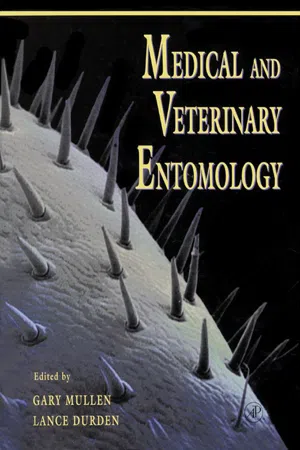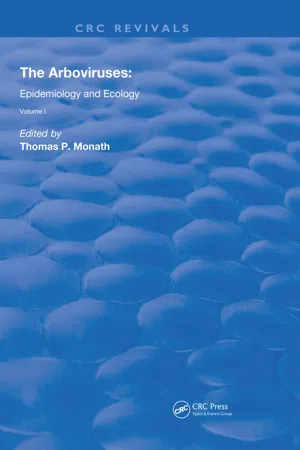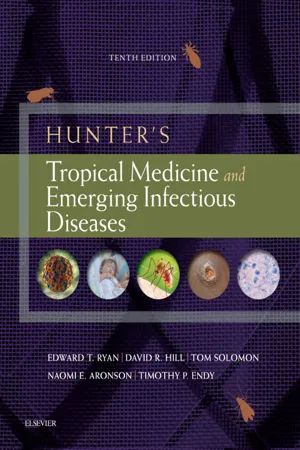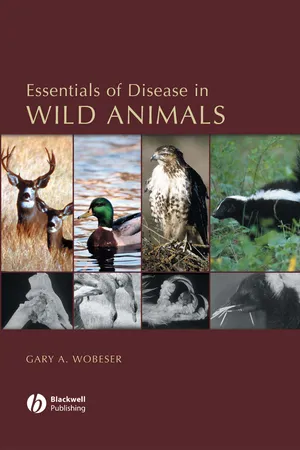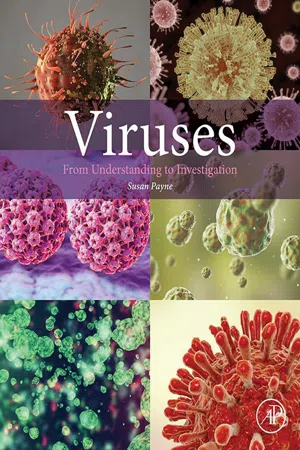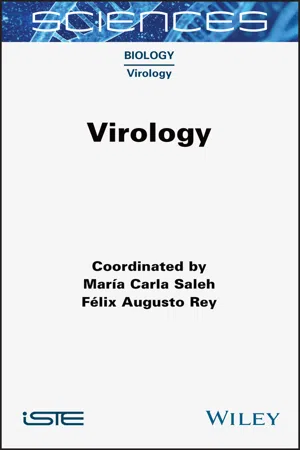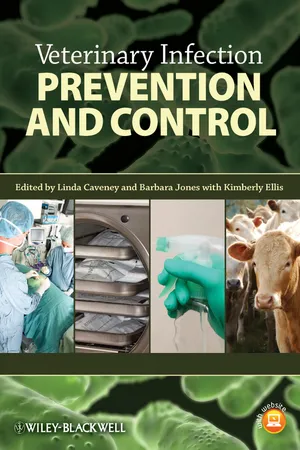Biological Sciences
Vector Transmission
Vector transmission refers to the process by which infectious agents, such as viruses or bacteria, are transmitted from one host to another through the bite of a vector organism, such as mosquitoes or ticks. The vector acts as a carrier for the pathogen, allowing it to be transferred to a new host during feeding. This mode of transmission is common in the spread of many diseases, including malaria and Lyme disease.
Written by Perlego with AI-assistance
Related key terms
Related key terms
1 of 4
Related key terms
1 of 3
8 Key excerpts on "Vector Transmission"
- eBook - ePub
- Gary R. Mullen, Lance A. Durden(Authors)
- 2002(Publication Date)
- Academic Press(Publisher)
epidemiology deals with the natural history and spread of diseases within human and animal populations. Vector-borne diseases consist minimally of a triad that includes an arthropod vector, a vertebrate host, and a parasite. The spread of pathogens by arthropods is especially complex, because in addition to interactions between the vertebrate host and the parasite, an arthropod is required for transmission of the parasite to uninfected hosts. Environmental factors such as temperature and rainfall impact these processes by affecting the rate of parasite maturation within the arthropod host, as well as arthropod abundance in time and space.A vector is an arthropod responsible for the transmission of parasites among vertebrate hosts. Vectors transmit parasites, not diseases. Disease is the response of the host to invasion by or infection with a parasite. A parasite is any organism, including viruses, bacteria, protozoa, and helminths, that is dependent upon the host for its survival. Parasites may or may not cause disease. When a parasite injures its host and causes disease, it is referred to as a pathogen or disease agent. A vector-borne disease , therefore, is an illness caused by a pathogen that is transmitted by an arthropod. Facultative parasites have both free-living and parasitic forms, whereas obligate parasites are totally dependent upon their host(s) to provide their requirements for life. Ectoparasites live on or outside the host, whereas endoparasites live inside the host. When interacting with their hosts, ectoparasites produce an infestation that typically remains topical or peripheral, whereas endoparasites produce an infection upon invasion of host tissues. The occurrence and severity of disease depends upon the host-parasite interaction after infection. A host carrying a parasite is infected , whereas an infected host capable of transmitting a parasite is infective. A host capable of parasite maintenance without clinical symptoms is a carrier. - eBook - ePub
The Arboviruses:
Epidemiology and Ecology
- Thomas Monath(Author)
- 2020(Publication Date)
- CRC Press(Publisher)
Chapter 5Horizontal and Vertical Transmission of Viruses by Insect and Tick Vectors
Michael J. Turell TABLE OF CONTENTS-
Introduction
-
Transmission Cycles
-
Incrimination of an Arbovirus Transmission Cycle
-
Mechanical Transmission
-
Biological Transmission
-
Infection of the Vector
-
Dissemination to the Hemocele
-
Infection of the Salivary Glands and Transmission
-
Extrinsic Incubation Period
-
-
Factors Affecting Vector Competence
-
Effect of Extrinsic Incubation Temperature
-
Effect of Viral Infection on the Vector
-
Effect of Viral Infection on the Vertebrate Host
-
Presence of Other Agents
-
-
Survival of Virus during Periods of Vector Inactivity
-
Survival in Long-Lived Vectors
-
Transovarial Transmission
-
Venereal Transmission
-
Summary
-
-
Summary
-
References
I. Introduction
When an arthropod feeds on a viremic host, there is potential for the arthropod to transmit the virus either mechanically or biologically. In the former case, the vector need not be susceptible to viral infection; while in the latter, virus must replicate in the vector before the virus can be transmitted. Once it has replicated in the vector, the virus may be transmitted either horizontally to a vertebrate by bite, or vertically to the vector’s progeny by transovarial transmission. Transovarially infected individuals then have the potential to retransmit the virus vertically to their progeny, or to transmit it horizontally either by bite to a vertebrate or venereally during mating. This chapter discusses various factors that have been shown to affect the efficiency with which arboviruses are transmitted by their potential vectors.II. Transmission Cycles
Traditionally, arboviruses are considered to be viruses that are capable of replication in both vertebrate and arthropod hosts and are transmitted by arthropods to vertebrates. Transmission cycles range from the relatively simple, involving only a single vector and vertebrate, to the highly complex, involving numerous vertebrate and vector species. As detailed natural histories are given for the various viruses in their respective chapters, only a few representative cycles are discussed here to illustrate general principles. Also, in this section, we consider only the horizontal or amplification cycle. The mechanism(s) by which arboviruses persist from year to year are discussed in the section on the survival of virus during periods of vector inactivity. - Edward T Ryan, David R Hill, Tom Solomon, Naomi Aronson, Timothy P Endy(Authors)
- 2019(Publication Date)
- Elsevier(Publisher)
Most vector-borne pathogens are zoonoses (pathogens of animals) and have a primary vertebrate reservoir host and a primary arthropod vector that maintains the transmission cycle in nature; this is usually via horizontal transmission but is sometimes facilitated by transovarial or vertical transmission (see later). This primary cycle is usually inapparent in humans and domestic animals. On occasion, the pathogen may be introduced into the peridomestic or urban environment by secondary vectors or by the vertebrate host, which often establishes a secondary transmission cycle involving other vertebrate hosts and arthropod vectors. Humans and domestic animals are usually infected by bridge vectors from these secondary cycles and are often dead-end or incidental hosts, not contributing to the transmission cycle. Recent studies suggest, however, that humans may in fact play a previously unappreciated role as reservoir during the transmission of pathogens and parasites in what is typically referred to as anthropogenic transmission (e.g., visceral leishmaniasis caused by Leishmania donovani in India and Sudan). A basic vector-borne pathogen transmission cycle is shown in Fig. 147.1. An arthropod can transmit a pathogen from one person or animal to another in one of two basic ways. Fig. 147.1 Transmission cycles for arthropod-borne infections. Mechanical Transmission Defined as transfer of a pathogen present on contaminated mouthparts or other body parts. There is no multiplication or developmental change of the pathogen on or in the insect. Examples include some enteroviruses, bacteria, and protozoa of human and veterinary importance. Insects, such as houseflies, can become contaminated with such pathogens while feeding on feces and transfer them to food- eBook - ePub
- Gary A. Wobeser(Author)
- 2013(Publication Date)
- Wiley-Blackwell(Publisher)
Trichinella spp. cause the disease trichinosis in humans that is often associated in North America with eating inadequately cooked bear meat. Larvae in the meat develop to the adult stage in the human alimentary tract. The adults produce larvae that localize in the person’s musculature, and both the intestinal and intramuscular stages of infection cause illness. Heavy infections may be fatal.It is more difficult to find suitable names for the hosts involved in indirectly transmitted diseases caused by viruses, bacteria, and some protozoa, because sexual replication is not a distinguishing feature. The species that is of greatest concern to humans (almost always the most highly valued vertebrate) is often called the “primary” host, and the other animal(s) involved are called alternate hosts or, in the case of invertebrates, vector species (table 8.5 ).Table 8.5Vectorborne Indirectly Transmitted DiseasesDisease (agent) Wildlife host of concern Vector Bluetongue, epizootic hemorrhagic disease of deer (oribiviruses) Deer, other ungulates Culicoides spp. (biting midges) Lyme disease (Borrelia burgdorferi) White-footed mouse, other rodents, birds Ixodes scapularis, I. ricinus (ticks) West Nile virus Wild birds Mosquitoes, primarily of the genus Culex Louping ill (flavivirus) Red grouse, mountain hare Ixodes ricinus (tick) Plague (Yersinia pestis ) Prairie dog and other rodents Rodent fleas Type A tularemia Lagomorphs Haemophysalis leporis-palustris and other ticks Ehrlichiosis (Ehrlichia spp.) Deer Ixodid ticks The word “vector” has been used in many ways. It is used in a general sense for “anything that allows the transport and/or transmission of a pathogen” or in a more restricted ecological sense as “a living creature which, because of its ecological relationship to others, acquires a pathogen from one living host and transmits it to another” (Toma et al. 1999b). Vector will be used here in a very restricted sense for a heterogenous group of blood-feeding arthropods that are involved in the indirect transmission of disease. These arthropods are infected with the agents, rather than simply having their external surfaces contaminated, and the disease agent develops or multiplies within the arthropod. - eBook - ePub
Viruses
From Understanding to Investigation
- Susan Payne(Author)
- 2017(Publication Date)
- Academic Press(Publisher)
Chapter 5Virus Transmission and Epidemiology
Abstract
Viral epidemiology is the study of the relationships among viruses and their hosts. An important aspect of viral epidemiology is spread. Viral epidemiologists try to predict the potential for development of an epidemic or pandemic and to determine appropriate interventions to contain an outbreak. Epidemiologists must try to account for a variety of factors involving both host and virus. These include, but are not limited to: mode of transmission, length of infection, and window of transmissibility, population density, living conditions, environment (climate, season), and stability of the virus. Modes of viral transmission include direct contact, exchange of body fluids, contact with infected fomites, inhalation, ingestion of contaminated food or water, and insects. Insect transmission can be complicated as the virus may replicate in the insect host or be passed vertically through eggs that survive for long periods in the environment. While medical personnel are interested in cases of disease, the epidemiologist must also consider infections that are silent or inapparent. Serological surveys are an important tool for detecting past viral infections. - eBook - ePub
- (Author)
- 2021(Publication Date)
- Wiley-ISTE(Publisher)
Transmission of plant viruses by their arthropod vectors is mediated by specific interactions between the plant, virus and vector. The determinants underlying evolution of the known Vector Transmission strategies include: location of transmissible virus within the vector arthropod (non-circulative vs. circulative); duration of the vector–virus relationship (non-persistent, semi-persistent and persistent); and replication status of the virus in the insect (non-propagative vs. propagative). Most plant viruses are transmitted horizontally by their arthropod vectors, although reoviruses, rhabdoviruses and tenuiviruses may also be vertically transmitted. This chapter highlights recent progress and longstanding questions in vector biology. The viral and arthropod determinants of vector competence for viruses, transmitted in non-circulative and circulative transmission modes, have revealed that even viruses transmitted via diverse transmission modes may interact with similar insect proteins during Vector Transmission. For example, insect cuticular proteins have been shown to be receptors for a non-circulative virus, as well as interacting with circulative viruses. Bacterial endosymbionts of vector insects play a role in vertical transmission of plant reoviruses, presenting the possibility that this may be a general method of virus transport into eggs for this group of viruses. During the last decade, development and applications of -omics technologies advanced our understanding of direct and indirect effects of viruses on their vectors; providing new insights into plant virus transmission, and opening up an area of study previously reserved only for model organisms. Other pivotal work in the field has focused on understanding the role of vector feeding on virus transmission and the multitrophic interactions between viruses, vectors and plants, and the indirect effects of pathogens on vector behavior and population dynamics. The basic research discussed in this chapter has practical implications for developing new control strategies for these complex and emerging vector-borne pathogens.The field of plant vector biology has a long history of impactful research by women scientists. From Marion Watson’s seminal research describing the transmission parameters that are still in use today, to the recent work highlighted in this chapter, the interdisciplinary nature of vector biology has provided an environment that promotes the integration of diverse ideas and lateral thinking (Watson et al. 1939). Plant vector biologists will undoubtedly continue to embrace new ideas and technologies, and diverse perspectives, to fully address these complex pathosystems that threaten global food security.7.2. Non-circulative virus transmissionNon-circulative virus transmission refers to viruses that are transiently and reversibly retained on the cuticle which lines the inner surface of the vector mouthparts (Figure 7.1 ) (Kennedy et al. 1962; Harris 1977). Retention within the vector is generally brief, and viruses are lost upon molting. The time periods required for virus acquisition and inoculation are short, with no latent period prior to virus inoculation. Vectors that have just acquired viruses are immediately capable of inoculating them in a new host plant. Historically, these viruses were classified according to the duration of acquisition and retention within the vector. Two categories were distinguished: non-persistent viruses acquired efficiently within seconds; semi-persistent viruses acquired within minutes to hours (Watson et al. 1939; Day et al. 1954; Sylvester 1956); and viruses being inoculated all within seconds or minutes. Semi-persistent viruses are mostly phloem-limited, while non-persistent viruses are not and are also present in epidermal, mesophyll or parenchyma cells. Semi-persistent viruses were initially assumed to be retained in the foregut of their vectors, and non-persistent viruses in the stylets. Although this is generally the case, an exception to this rule is the cauliflower mosaic virus (CaMV), classified as semi-persistent (Markham et al. 1987) and shown to bind receptors at the tip of aphid stylets (Uzest et al. 2007). The two terminologies based on the type of virus–vector interaction and on the duration of the transmission phases co-exist in the literature (Harris 1977; Kennedy et al - eBook - ePub
Insects and Wildlife
Arthropods and their Relationships with Wild Vertebrate Animals
- John Capinera(Author)
- 2011(Publication Date)
- Wiley-Blackwell(Publisher)
Because another species is involved in the transfer from host to host, it is considered to be a form of indirect transmission. Not surprisingly, direct transmission is defined as the transfer of a disease agent (pathogen) from one host to another without the involvement of another species. Transmission of an infective stage of a disease agent to a host can occur in various ways. Passive transmission occurs when the host is contaminated or infected accidentally through ingestion of food, water, or an infected arthropod; this occurs with many nematodes. Active transmission occurs when the disease agent actively penetrates the bodies of their host after gaining contact with them; this occurs with hookworms. Finally, inoculative transmission occurs when a vector such as a mosquito injects the disease agent into the new host during the process of blood feeding, as occurs with the protozoa causing malaria. The importance of arthropod transmission as a means of disease spread varies greatly among diseases. For some wildlife diseases it is the only means or most important form of transmission, but for other diseases it is less important or arthropod transmission does not occur. It is useful to note that transmission of disease agents by arthropods is not completely independent of the other routes of horizontal transmission. Arthropods can be associated with food and carrion, for example, and wildlife could contract a disease from an insect or by feeding on contaminated food. Nevertheless, because an arthropod (serving as a ‘vector’) is involved in the transmission or transport process, such diseases are called vector-borne. Vectors differ in their ability to acquire disease agents and to infect hosts (vector competence). Insects usually are short-lived, and acquire and transmit disease agents quickly, with the incubation period in the vector lasting perhaps a few days. Insects may be quite mobile, and typically take many small blood meals - eBook - ePub
- Linda Caveney, Barbara Jones, Kimberly Ellis, Linda Caveney, Barbara Jones, Kimberly Ellis(Authors)
- 2011(Publication Date)
- Wiley-Blackwell(Publisher)
However, most infectious agents also have some common features that can be exploited in design of effective control strategies against more than one pathogen (see Figure 3.1). Transmission of infectious pathogens between hosts can occur via a variety of routes, as shown in Table 3.3. Transmission patterns are closely linked to the individual pathogen's biology. Similarly to the variability in characteristics of different infectious agents, there is also a great variability in the way those pathogens transmit from one host to another. However, although specific details can vary, most pathogens have to follow the same basic general steps to enable them to establish infections in susceptible hosts. These basic common steps include entry, replication and spread within the host (either locally or systemically), and exit to enable infection of the new host. The cycle of infection can be divided into an incubation period, disease (may be subclinical), and recovery (or death). In addition, most pathogens have to be able to survive in the outside environment for long enough to enable a chance exposure of a new susceptible host and subsequent establishment of a new infection. Figure 3.1 shows the steps in the transmission of disease. Figure 3.1 “Links in the chain of disease transmission”: Critical steps in transmission cycles of infectious pathogens and examples of actions that can facilitate breakage of the transmission cycle. Route of Entry Respiratory and gastrointestinal tracts are the most common routes of entry for pathogenic microorganisms. Other possible routes include entry through skin abrasions, wounds, conjunctiva, urogenital tract, or placenta. Some pathogens use exclusively one route of entry, whereas others can use several different ones. For example, arboviruses such as West Nile virus, equine encephalitis viruses, or African horse sickness virus are transmitted via bites of infected arthropod vectors (mosquitoes or midges)
Index pages curate the most relevant extracts from our library of academic textbooks. They’ve been created using an in-house natural language model (NLM), each adding context and meaning to key research topics.
Explore more topic indexes
Explore more topic indexes
1 of 6
Explore more topic indexes
1 of 4
